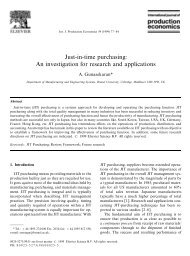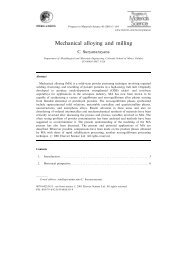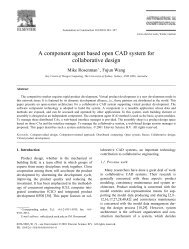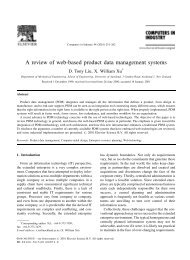Internet-based intensive product design platform for ... - GRACO
Internet-based intensive product design platform for ... - GRACO
Internet-based intensive product design platform for ... - GRACO
You also want an ePaper? Increase the reach of your titles
YUMPU automatically turns print PDFs into web optimized ePapers that Google loves.
Table 1<br />
EXPRESS in<strong>for</strong>mation model of rolling bearing<br />
STEP in<strong>for</strong>mation model<br />
SCHEMA rolling_bearing_support_schema:<br />
ENTITY bearing:<br />
style: STRING;<br />
static_load: REAL;<br />
dynamic_load: REAL;<br />
weight: REAL;<br />
limited_speed_with_oil: REAL;<br />
limited_speed_with_grease: REAL;<br />
external_diameter: REAL;<br />
inner_diameter: REAL;<br />
width: REAL;<br />
install_damin: REAL;<br />
install_damax: REAL;<br />
install_rasmax: REAL;<br />
other_d2_inner: REAL;<br />
other_d2_external: REAL;<br />
other_rsmin: REAL;<br />
END_ENTITY:<br />
END_SCHEMA:<br />
he can use not only the repositories inside the commercial<br />
CAD system, but also the common outside repositories via<br />
<strong>Internet</strong> control. Due to the common repositories are<br />
maintained by knowledge (<strong>product</strong>s) providers, they can<br />
quickly be updated and kept up to date. Since knowledge<br />
providers are distributed in all kinds of disciplines and to<br />
various sites, the knowledge in the repositories of the IPDP<br />
can abundantly contain distributive, various discipline<br />
knowledge resources. Consequently, a robust <strong>intensive</strong><br />
<strong>product</strong> <strong>design</strong> <strong>plat<strong>for</strong>m</strong> is <strong>for</strong>med.<br />
To achieve this IPDP framework successfully, there are<br />
server all-important issues need to be solved. Firstly, the<br />
common repositories of IPDP are distributed at various<br />
locations, domains and disciplines. And the knowledge<br />
stored in them should be utilized with various <strong>design</strong><br />
<strong>plat<strong>for</strong>m</strong>s. So the knowledge must be represented with a<br />
neutral <strong>for</strong>m independent of <strong>design</strong> <strong>plat<strong>for</strong>m</strong>s, meanwhile, it<br />
should be understood by them via knowledge processor.<br />
Secondly, because the IPDP is constructed over the <strong>Internet</strong><br />
and its knowledge repositories is a dynamic league of<br />
knowledge sites, an efficient method of knowledge search<br />
within <strong>Internet</strong> environment must be provided to assure the<br />
running per<strong>for</strong>mance of IPDP. The following content then<br />
will discuss these issues in detail.<br />
3. Knowledge representation<br />
As stated in Section 2, a key issue of the IPDP is that the<br />
knowledge retrieved from the repositories of IPDP should<br />
be directly utilized <strong>for</strong> various <strong>design</strong> <strong>plat<strong>for</strong>m</strong>s. So, if the<br />
knowledge is still represented in a traditional handbook with<br />
such things as data, tables and, diagrams, the user must<br />
translate the knowledge into a <strong>for</strong>mat that his <strong>design</strong><br />
<strong>plat<strong>for</strong>m</strong> can understand. For example, a <strong>product</strong> <strong>design</strong>er<br />
S. Zhou et al. / Knowledge-Based Systems 16 (2003) 7–15 9<br />
needs a rolling bearing when he <strong>design</strong>s the structure of a<br />
<strong>product</strong> with a Solidworks <strong>plat<strong>for</strong>m</strong>. If the <strong>product</strong> <strong>design</strong>er<br />
gains the detailed structure of the rolling bearing from a<br />
traditional <strong>for</strong>mat such as a handbook, table or diagram, it<br />
cannot be directly understood in a Solidworks <strong>plat<strong>for</strong>m</strong>. As<br />
a result, the <strong>design</strong>er must draw a rolling bearing with<br />
Solidworks using the rolling bearing in<strong>for</strong>mation as<br />
represented in traditional handbook <strong>for</strong>m. This indicates<br />
that the traditional handbook representation limits the level<br />
of knowledge utilization and the speed of <strong>product</strong><br />
development.<br />
Since the repositories of the IPDP are independent of the<br />
application <strong>plat<strong>for</strong>m</strong>, and the knowledge acquired by the<br />
<strong>design</strong>er requires that it directly utilize the application<br />
<strong>plat<strong>for</strong>m</strong>, the knowledge representation must be standardized.<br />
The standard <strong>for</strong> the exchange of <strong>product</strong> model data<br />
(STEP) [8,9], released by ISO, can implement the<br />
in<strong>for</strong>mation expression depending on various application<br />
<strong>plat<strong>for</strong>m</strong>s. It is a standard <strong>based</strong> on the EXPRESS language<br />
[10], which can grow and can be extended to any industry<br />
and will not be outdated as soon as it is published. The<br />
EXPRESS language describes constraints as well as data<br />
structure. The <strong>for</strong>mal rules of the STEP standard will<br />
prevent conflicting interpretations. The knowledge represented<br />
in the STEP standard can felicitously meet the<br />
requirements of the IPDP system on the knowledge<br />
representation <strong>for</strong>m. Since STEP provides a mechanism<br />
<strong>for</strong> describing <strong>product</strong> data models and EXPRESS featureneutral<br />
and independent of any application <strong>plat<strong>for</strong>m</strong>.<br />
Besides the traditional <strong>for</strong>m, in this paper, the knowledge<br />
in common repositories of the IPDP is also represented with<br />
EXPRESS language <strong>based</strong> on the STEP standard. Hence,<br />
the <strong>design</strong>er can acquire not only the traditional handbook<br />
<strong>for</strong>m but also the STEP in<strong>for</strong>mation model of knowledge<br />
from repositories of the IPDP. The STEP contains all<br />
in<strong>for</strong>mation of this knowledge as expressed in traditional<br />
handbook <strong>for</strong>m in data, table and diagram style. When a<br />
<strong>design</strong>er retrieves knowledge from repositories of the IPDP,<br />
he first downloads the STEP in<strong>for</strong>mation model of knowledge<br />
and, then employs the STEP pre/post processor,<br />
translating the STEP in<strong>for</strong>mation into a <strong>for</strong>m understood by<br />
the application <strong>plat<strong>for</strong>m</strong>. By this mean, the knowledge can<br />
be quickly and directly utilized in various <strong>product</strong> <strong>design</strong><br />
<strong>plat<strong>for</strong>m</strong>s.<br />
Taking the rolling bearing as an example, we note in<br />
Table 1 that the representation <strong>for</strong>m of knowledge (rolling<br />
bearing) in the repositories of IPDP is described with<br />
EXPRESS language. This knowledge model then is<br />
translated into a data dictionary model using the EXPRESS<br />
compiler (e.g. ST-Deeloper8.0 [11]). The data dictionary is<br />
a knowledge model that is not populated (e.g. a class of<br />
rolling bearing), meaning that the model attributions are<br />
not endued with exact values. The bearing’s code is in a<br />
binary <strong>for</strong>mat, which can be directly read by machine<br />
(<strong>for</strong> example, after being compiled, the data dictionary<br />
of the in<strong>for</strong>mation model rolling_bearing_support_schema






